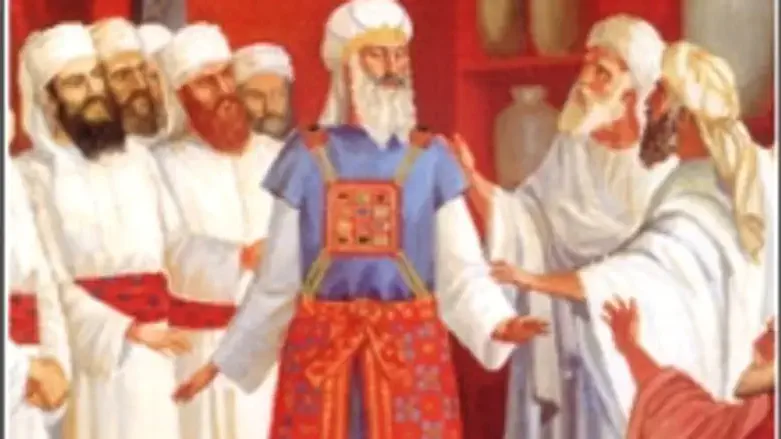

Rabbi Dovi Holtz is a former Bachur in Memphis (2002-03) and Avrech, London (2007-09). He is urrently a Tanach teacher, and author of "One who loves Tanach"
Before writing these lines, I had to answer an essential question about myself. What am I more? A person or a Yekke? To clarify what I mean, I would like to present a famous theological question, "Where does the soul reside?"
The three main schools of thought in the Ashkenazi world are:
1. The heart – which is why Chasidim wear a gartel when they daven.
2. The brain – which is why Litvaks wear a tie when they daven
3. The hand – which is why Yekkes wear a watch when they daven.
And since it was never really in doubt, I would like to try and unravel, or at least present, some questions I have regarding Yom Kippur and time.
When looking at the sources that discuss Yom Kippur in the Torah, it would seem that they should be divided into three categories.
The first source (even though it is third chronologically) appears in Bamidbar 29:7-11 and mostly teaches us about the Musaf sacrifices that should be offered on that day, as on every other holiday.
The second source, Vayikra 23:26-32, mentions the do’s (fast and rest) and don'ts (eat and work) that apply on this very special day, once again, as a part of the Jewish calendar.
The third source (or first), all of chapter 16 of Vayikra, discusses the exclusive sacrificial rites that are unique to Yom Kippur.
As opposed to the two other sources, that include Yom Kippur as an integral part of the Jewish year, the verses discussing Seder Ha’Avoda (Vayikra 16) seem to mention the date almost as an afterthought.
When Hashem tells Aharon not to enter the Kodesh at all times - "ואל יבא בכל עת אל הקדש" (Vayikra 16:2), we would expect that the next piece of information provided would be the time when he is allowed to enter the holiest part of the Mikdash, the Kodesh Kodashim (a.k.a. Yom Kippur). Instead, we encounter a list of actions that Aharon must perform in order to enter properly:
Come in with incense. Bring a bull. Wear specific clothes, etc. Only in verse 29 is it noted that there is a specific date on which all this is supposed to take place; The tenth day of the seventh month. This could raise some eyebrows if we remember that the first thing we expected to be answered was "when?"
With this question in mind, I decided to turn to my trusty companions, the Peshat commentators, and hope that salvation will come from them. Unfortunately, the vast majority of them did not originate in the Jewish communities in Germany, and therefore, it seems that they were less interested in this wild conundrum than myself. The only medieval Peshat commentator I could find who mentioned my question, the Ramban, did so in passing and dismissed it; "and the meaning of 'at all times' – since Yom Kippur was already mentioned (Shemot 30:10)… now the date was explained…"
Not really satisfied, I broadened my search and discovered two very interesting elucidations, the first by Yalkut Shimoni and the second was Rabbi Shlomo Ephraim Lunschitz (the Kli Yakar).
Yalkut Shimoni claims that Aharon could enter at any time the Holy of Holies, as long as he did so as described. This would seem to contradict the Halakha as brought in the Mishnah and the Rambam, that the Cohen Gadol could enter Kodesh Hakodashim only one day a year!
Similarly, the Kli Yakar says that from the beginning of the chapter it would seem that the Cohen cannot enter at all times, but he can do so occasionally. This does not seem to be the case when we continue reading the chapter, where it appears he could only enter once a year. Due to this problem, the Kli Yakar explains that entering the Holy of Holies, depends on the state of holiness of the Jewish people. In an ideal world, the Cohen should be able to enter at any given time, since ideally there would be no sin. But being that we live in the real world, where sin is abundant, the only time to enter Kodesh Hakodashim is Yom Kippur, a day described by the Kli Yakar as "a day outside the realm of time."
In conclusion, it would seem that there are two ways to enter the Holy of Holies.
The first is as a part of this world and a part of the calendar, confined by all the Halakhic boundaries of this world.
The second, like its equivalent in space, Kodesh Hakodashim, is not part of this world, and therefore not confined to a specific date, but to a state of Jewish being. This second option does not have halakhic, or other boundaries, because it is not part of our world, rather some kind of Utopia.
For the time being, I will have to stick to the halakhic boundaries of the first option, i.e., Yom Kippur. But I will allow my human side to pray for the day when time is no longer an issue, and we will be able to enter at any time.
Gmar Chatima Tova!
~
For comments:doviholtz@gmail.com